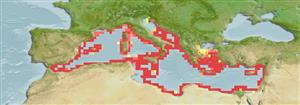Classification / Names
आम नाम | उपशब्द | Catalog of Fishes(वर्ग, प्रजाति) | ITIS | CoL | WoRMS | Cloffa
इलाज़मौबरांकी (शारक और रेज़) (sharks and rays) >
Myliobatiformes (Stingrays) >
Dasyatidae (Stingrays) > Dasyatinae
Etymology: Dasyatis: Greek, dasys = rough, dense (Ref. 45335).
Environment: milieu / climate zone / depth range / distribution range
पारिस्थितिकी
समुद्री ड़िमरसल; गहराई सीमा 100 - 200 m (Ref. 51024). Temperate; 46°N - 30°N, 6°W - 36°E
Northeast Atlantic: known only from the Mediterranean. Validity of this species questioned in Compagno's 1999 checklist (Ref. 35766).
आकार / वज़न / Age
Maturity: Lm ? range ? - ? cm
Max length : 80.0 cm WD पुल्लिंग / अलिंग; (Ref. 3169); common length : 65.0 cm WD पुल्लिंग / अलिंग; (Ref. 3169)
Found over sandy and muddy bottoms. Feeds on bottom-living invertebrates and fishes. Ovoviviparous, gestation about 4 months and about 6 to 9 young are produced.
Life cycle and mating behavior
परिपक्व अवधि | पुनरुत्पत्ति | मछलीऔ का अंडे देना | अंडे | Fecundity | लार्वा
Exhibit ovoviparity (aplacental viviparity), with embryos feeding initially on yolk, then receiving additional nourishment from the mother by indirect absorption of uterine fluid enriched with mucus, fat or protein through specialised structures (Ref. 50449). Distinct pairing with embrace (Ref. 205).
McEachran, J.D. and C. Capapé, 1984. Dasyatidae. p. 197-202. In P.J.P. Whitehead, M.-L. Bauchot, J.-C. Hureau, J. Nielsen and E. Tortonese (eds.) Fishes of the north-eastern Atlantic and Mediterranean. UNESCO, Paris. Vol. 1. (Ref. 3169)
IUCN Red List Status (Ref. 130435)
Threat to humans
Harmless
Human uses
अधिक जानकारी
Age/Sizeबाढ़Length-weightLength-lengthLength-frequenciesमौरफोमैटरिक्सआकृति विज्ञानलार्वालारवल गतिकीभर्तीबहुतायतBRUVS
संदर्भजलीयकृषिजलीयकृषि रूपरेखाखींचआनुवंशिकीElectrophoresesहैरेटिबिलटीबीमारीप्रक्रमणNutrientsMass conversion
साधन
Special reports
Download XML
इंटरनेट स्रोत
Estimates based on models
Preferred temperature (Ref.
123201): 13.3 - 16.1, mean 14.9 °C (based on 33 cells).
Phylogenetic diversity index (Ref.
82804): PD
50 = 0.5002 [Uniqueness, from 0.5 = low to 2.0 = high].
Bayesian length-weight: a=0.00646 (0.00265 - 0.01571), b=3.06 (2.86 - 3.26), in cm total length, based on LWR estimates for this (Sub)family-body shape (Ref.
93245).
Trophic level (Ref.
69278): 4.0 ±0.62 se; based on food items.
लौटाव (Ref.
120179): बहुत नीचे, न्यूनतम जनसंख्या दुगनी समय अवलागत 14 महीने। (Fec=6-9).
Fishing Vulnerability (Ref.
59153): Very high vulnerability (78 of 100).
Nutrients (Ref.
124155): Calcium = 11.4 [2.2, 51.3] mg/100g; Iron = 0.269 [0.072, 0.742] mg/100g; Protein = 22 [19, 25] %; Omega3 = 0.532 [0.144, 1.564] g/100g; Selenium = 10.9 [3.1, 28.5] μg/100g; VitaminA = 11.5 [3.8, 33.6] μg/100g; Zinc = 0.407 [0.196, 0.714] mg/100g (wet weight);
